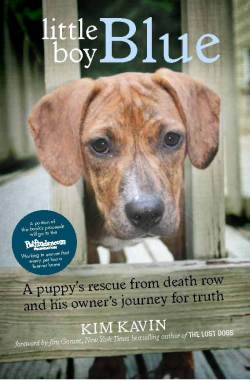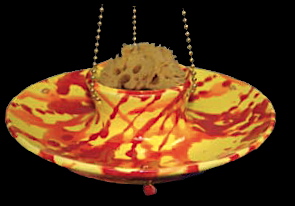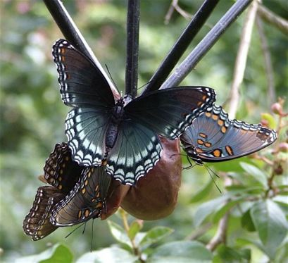-
Little Boy Blue: A Puppy’s Rescue from Death Row and his Owner’s Journey for Truth
A brief summary of the book: When journalist Kim Kavin decided that she wanted a puppy, she did what millions of people do every year: clicked on an online photo and submitted an application. She had no idea that the adorable brindle–advertised as healthy and near her home in New Jersey–was actually a last-minute rescue from a gas-chamber shelter in North Carolina.
Blue had arrived in the Northeast with at least a dozen other dogs in an RV that is just one among countless transports whose sponsors are dedicating their efforts to saving dogs by any means possible. Blue was happy and friendly, but he seemed to have endured some unusual albeit unknown ordeal. The dog’s manner prompted Kavin to trace his history all the way back to a long row of cages where Blue had been tagged to be put down in just three more days.
Little Boy Blue is the true story of one sweet puppy’s journey of survival. It’s also a shocking exposé that describes a brutal ongoing reality inside some of this country’s taxpayer-funded shelters. But Little Boy Blue also tells an inspiring story of the grass-roots rescue network that has exploded across the nation in recent years. Readers will come to know and love a very special dog who now brings smiles to the faces of everyone he meets.
From a single click of Kim Kavin’s computer mouse, Blue’s journey of a lifetime began. This is the story of Little Boy Blue, told with candor and a great deal of love.
5 Practical Tips for Adopting a Dog by Kim Kavin
Get a full veterinary assessment in the first few days.
Shelters and rescue groups work hard to ensure that all puppies and dogs are healthy before they are adopted. However, because the dogs have been in a shelter environment, it is possible that something may have been overlooked. Take your new dog to your trusted veterinarian and get a full workup to be sure there are no undiagnosed health issues. The most common challenge with dogs coming straight out of a shelter (as opposed to a foster home) is diarrhea that requires a few days of antibiotics to clear up completely. Young puppies may also require booster shots for rabies and other standard vaccinations.
Expect a transition period of one to two weeks.
Any dog moving from a shelter or rescue environment into a home is going to need an adjustment period. Try to imagine how you might feel coming out of a bare prison cell and into a home full of adults and kids, new smells, and new things. It usually takes a dog one to two weeks to settle down, feel at home, and show his true personality. Your job during this time is to provide love, stability, and encouragement. It is unrealistic to expect training or any other serious lessons to take hold during this transition period. Your goal during this time is to create a bond with your new dog so that he knows he can trust you.
Be prepared with a crate, a leash, chew toys, and training treats.
All new dogs, especially puppies, need to be shown what is—and is not—okay for them to do in a new home. They don’t need discipline. They need education. Crate training is ideal because the crate gives the dog his own space where he feels safe, and where you know that he isn’t going to hurt himself or wreck your house. It’s a win-win. Also have plenty of chew toys and teething bones, especially for puppies, so you can teach your dog to chew on those instead of on rugs or furniture. Training treats that are small and low-calorie should always be at the ready, too. Keep them in your pocket so that when your new dog does something good, you can reward him. Also keep your new dog on a leash at all times when outside your home. Until he knows his name and the command “come,” a leash is the only way that you will be able to get him back.
Create a daily routine to help with quick housebreaking and early training.
Dogs, including puppies, are creatures of routine. Start on Day One by teaching your dog that the first thing to do after waking is to go outside and make potty. Out of the crate, and out the back door, right in succession. Take him outside five or six times a day if you can during the first week, always rewarding him with a treat when he makes potty outdoors. Make going potty the last task before bedtime, too. If you stick with this routine, your dog will be housebroken faster. He will learn that if he wants treats all day long, then he has to keep going outside to go potty. He will also learn where the door is to the outside, so he can start to walk there on his own and alert you when he needs to go out.
Enroll in puppy kindergarten or beginner obedience classes.
Obedience school is a must for anyone who wants their dog to grow up well-behaved. It doesn’t matter if you’ve had ten dogs before this one. All dogs need training outside the home, in environments where there are distractions including other dogs. Your dog may be able to “stay” in your kitchen, but that’s not going to do you much good at a park full of people he wants to meet. Investing a little bit of time early-on at obedience school is the best thing you can do to ensure that your dog will be a great family member for many years to come. Take several courses if you can. Don’t stop at just one. The more time you spend on obedience during your dog’s first year with you, the easier your life is going to be in the long run.
- Bats & Butterflies, Bird Accessories, Butterfly Feeder, Fruit Bird Feeder, Squirrel Feeder, Uncategorized
Unusual Butterfly Feeders offer great versatility, and a cool metamorphosis video too!
Love cool stuff! These butterfly feeders(coming soon) do double duty for fruit lovers like; Warblers, Thrashers, Woodpeckers, and lots of other migratory friends who adore fruit and/or jelly. An Oriole’s favorite, the center may be filled with jelly, while orange quarters are placed right along side.
As a nectar feeder for butterflies, the sea sponge is included. It acts as a wick-absorbing the liquid because butterflies will not drink from an open source. This method recreates how the flying gems actually draw nectar from flowers. Over-ripened fruit may also be placed on the outer dish, offering butterflies a varied and swell refuge.
Handcrafted of weather-proof stoneware, lead-free glazes, and brass chain, it’s safe outdoors year-round. The feeder may also be placed in the dishwasher for a quick & thorough cleaning. Lure butterflies to your place offering nectar and fruit together in this groovy, hand-made feeder.
And speaking of fruit, butterflies enjoy a variety of over-ripened ones. Grapes, oranges, melons, peaches, apples and berries will entice them to nibble and come back for more. This durable stalk feeder is perfect for creating a fruit smorgasbord, even corn on the cob works well in winter after butterfly migration is complete. (Yes… some folks really do feed the squirrels!)
Of course habitat plays a key role in attracting butterflies, and omitting pesticides will prove most beneficial. Nectar-producing flowers (lantana, abelia, and butterfly bush) are most common, and should be included in the landscape. Host plants are also required, and will likely deteriorate with munching! Milkweed, parsley and cabbage are a few favorites caterpillars love (and need) for growth to chrysalis stage.
Ever witnessed the stages of a butterfly metamorphosis? Until seeing the video below, I can’t say that I have! Truly a masterpiece of nature, it’s worth the watch!
-
Master of Mimicry~A Cool Video from The Cornell Lab
An extremely cool video from The Cornell Lab of Ornithology, one special catbird in California (which is rare in itself) puts on an extreme show. Known as a master of mimicry, over twenty calls are recorded, side by side with the originator…. even a frog!
Pretty common in our parts during summer months, we had several resident catbirds hanging around the yard this season. Digging into suet and a jelly feeder–until the yellow jackets showed up, they then opted for worms meant for bluebirds! Crafty & smart, they’d wait and watch until the open dish melworm feeder came alive once again.
Actually it became obnoxious, as the worms were for the baby bluebirds! But there were breeding pairs nearby and catbird fledges were soon at the feeder too. It sure was a busy season, likely because of diminished food sources and the horrid drought. Two leaf misters ran daily, and nine birdbaths were maintained! It was great having catbirds around, but good to see them move on as well.
Check out the short video below for some excellent catbird knowledge!




